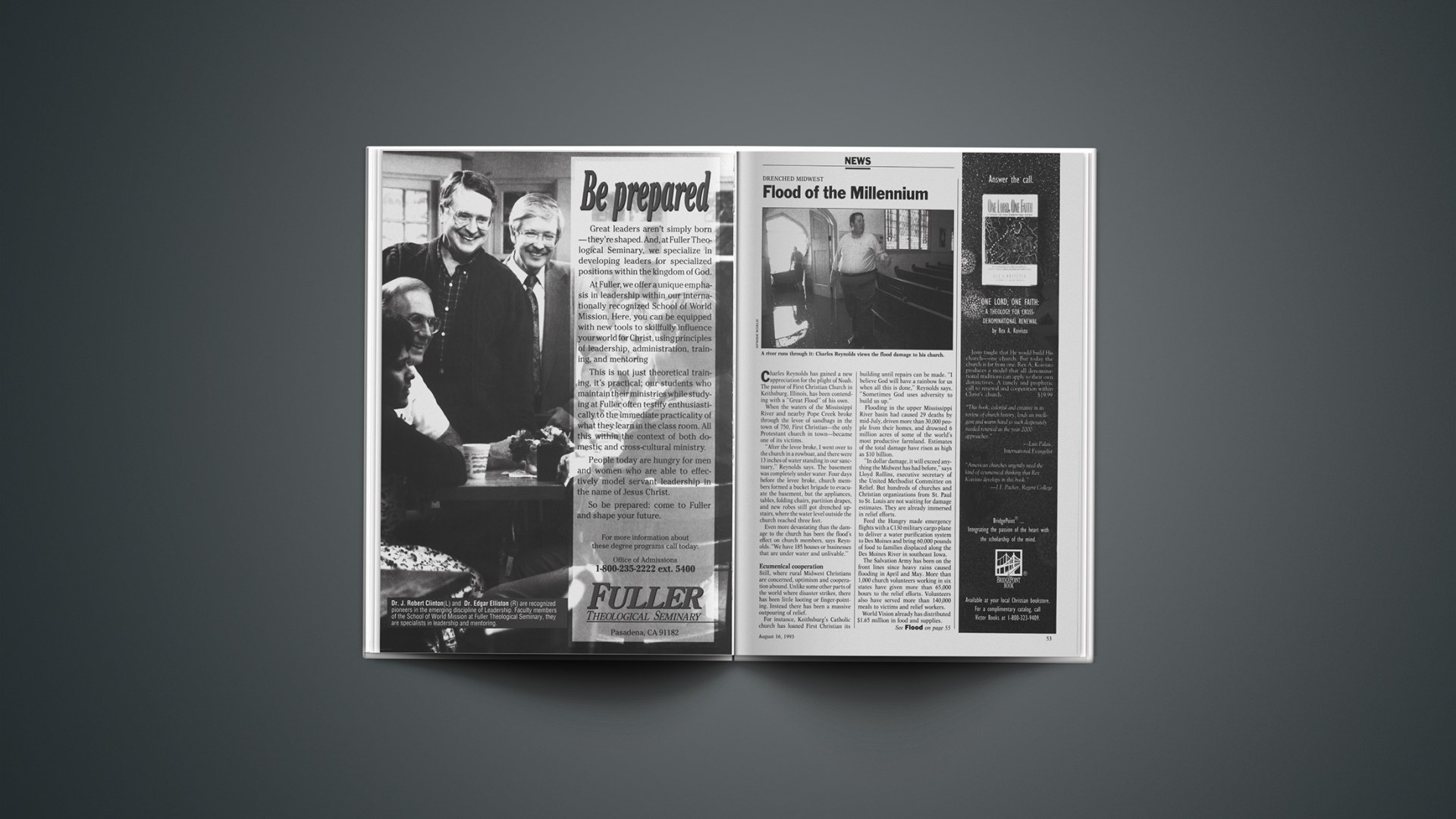Charles Reynolds has gained a new appreciation for the plight of Noah. The pastor of First Christian Church in Keithsburg, Illinois, has been contending with a “Great Flood” of his own.
When the waters of the Mississippi River and nearby Pope Creek broke through the levee of sandbags in the town of 750, First Christian—the only Protestant church in town—became one of its victims.
“After the levee broke, I went over to the church in a rowboat, and there were 13 inches of water standing in our sanctuary,” Reynolds says. The basement was completely under water. Four days before the levee broke, church members formed a bucket brigade to evacuate the basement, but the appliances, tables, folding chairs, partition drapes, and new robes still got drenched upstairs, where the water level outside the church reached three feet.
Even more devastating than the damage to the church has been the flood’s effect on church members, says Reynolds. “We have 185 houses or businesses that are under water and unlivable.”
Ecumenical cooperation
Still, where rural Midwest Christians are concerned, optimism and cooperation abound. Unlike some other parts of the world where disaster strikes, there has been little looting or finger-pointing. Instead there has been a massive outpouring of relief.
For instance, Keithsburg’s Catholic church has loaned First Christian its building until repairs can be made. “I believe God will have a rainbow for us when all this is done,” Reynolds says. “Sometimes God uses adversity to build us up.”
Flooding in the upper Mississippi River basin had caused 29 deaths by mid-July, driven more than 30,000 people from their homes, and drowned 6 million acres of some of the world’s most productive farmland. Estimates of the total damage have risen as high as $10 billion.
“In dollar damage, it will exceed anything the Midwest has had before,” says Lloyd Rollins, executive secretary of the United Methodist Committee on Relief. But hundreds of churches and Christian organizations from St. Paul to St. Louis are not waiting for damage estimates. They are already immersed in relief efforts.
Feed the Hungry made emergency flights with a C130 military cargo plane to deliver a water purification system to Des Moines and bring 60,000 pounds of food to families displaced along the Des Moines River in southeast Iowa.
The Salvation Army has been on the front lines since heavy rains caused flooding in April and May. More than 1,000 church volunteers working in six states have given more than 65,000 hours to the relief efforts. Volunteers also have served more than 140,000 meals to victims and relief workers.
World Vision already has distributed $1.65 million in food and supplies.
Nowhere is the flood’s punch more evident than in Des Moines, where the water purification system was ruined by flood waters, leaving the city’s residents dependent on outside sources for potable water.
Thirty pastors in the Evangelical Ministerial Association banded together to offer a practical and spiritual response to the crisis. “We want this to have a distinctly Christian witness and we don’t want to duplicate efforts,” says Bruce Wittern of Easton Place United Methodist Church.
A chaplaincy program for both relief volunteers and those devastated by the flood has offered a Christian presence and encouragement. “The volunteers are getting stressed out and snappy. Some of them are putting in 16-hour days,” Wittern says, “And the people at the homeless sites are really at the end of their ropes.” One volunteer chaplain ended up taking a suicide call from someone despondent over his losses.
The ministerial association also has organized a Christian Executive Relief Committee, which is working with other Christian organizations such as World Vision and World Relief. And churches are distributing “response action forms” that allow church members to designate what they need or what they can do. Wittern says, “Were going to try to match the needs with people who can help.”
More than 2,000 members of 40 churches gathered July 18 for a Flood Relief Rally at First Federated Church in Des Moines. An “altar call” netted 500 volunteers for cleaning projects.
Further downstream, assembly lines of volunteers have been slapping together sandwiches nearly around the clock in the “disaster kitchen” at Edmundson Road Baptist Church in St. Louis.
“We’re preparing about 5,500 to 6,000 meals a day,” says Jim Albers, director for the Missouri Baptist Convention’s disaster relief program. Most are delivered to hungry sandbaggers and other relief workers, but an increasing number are being used to feed displaced homeowners and farmers.
Albers says the response to calls for volunteers has been fantastic. “We’ve been really blessed by enthusiasm and Christian spirit,” Albers says. “But we plan to be here for the duration. We’re a long way from being out of the woods.”
Given the Midwestern bedrock values and fortitude in a crisis, volunteers will be around until they are no longer needed.
By Heidi Schlumpf Kezmoh.










